ignition CITROEN C1 2018 User Guide
[x] Cancel search | Manufacturer: CITROEN, Model Year: 2018, Model line: C1, Model: CITROEN C1 2018Pages: 269, PDF Size: 7.63 MB
Page 45 of 269
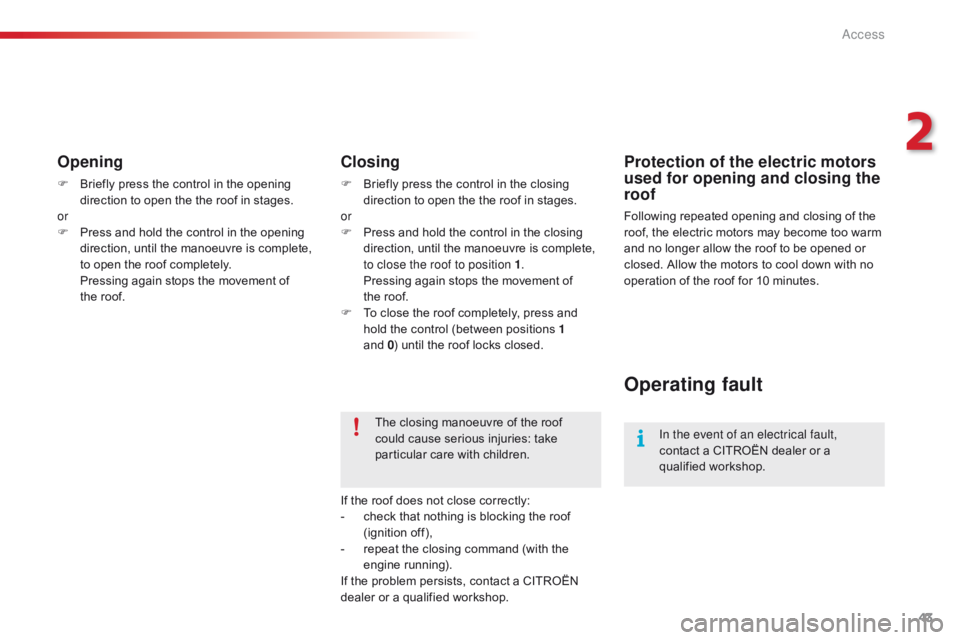
43
C1_en_Chap02_ouvertures_ed01-2016
Opening
F Briefly press the control in the opening d
irection to open the the roof in stages.
or
F
P
ress and hold the control in the opening
d
irection, until the manoeuvre is complete,
t
o open the roof completely.
P
ressing again stops the movement of
the
roof.
Closing
F Briefly press the control in the closing d
irection to open the the roof in stages.
or
F
P
ress and hold the control in the closing
d
irection, until the manoeuvre is complete,
t
o close the roof to position 1 .
P
ressing again stops the movement of
t
he roof.
F
T
o close the roof completely, press and
h
old the control (between positions 1
and
0)
until the roof locks closed.
The
closing manoeuvre of the roof
c
ould cause serious injuries: take
p
articular care with children.
If
the roof does not close correctly:
-
c
heck that nothing is blocking the roof
(
ignition
o
ff),
-
r
epeat the closing command (with the
e
ngine
r
unning).
If
the problem persists, contact a CITROËN
d
ealer or a qualified workshop.
Operating fault
In the event of an electrical fault,
contact a CITROËN dealer or a
q
ualified
w
orkshop.
Protection of the electric motors
used for opening and closing the
roof
Following repeated opening and closing of the roof, the electric motors may become too warm
a
nd no longer allow the roof to be opened or
c
losed. Allow the motors to cool down with no
o
peration of the roof for 10 minutes.
2
Access
Page 46 of 269
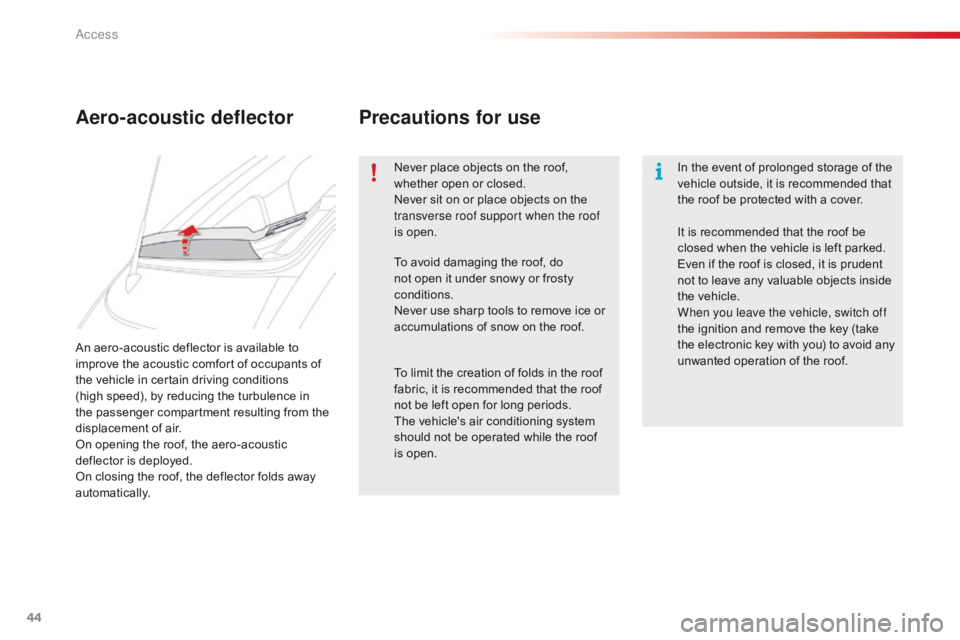
44
C1_en_Chap02_ouvertures_ed01-2016
An aero-acoustic deflector is available to improve the acoustic comfort of occupants of
t
he vehicle in certain driving conditions
(high
speed), by reducing the turbulence in
t
he passenger compartment resulting from the
d
isplacement of air.
On
opening the roof, the aero-acoustic
d
eflector is deployed.
On
closing the roof, the deflector folds away
au
tomatically.
Aero-acoustic deflector Precautions for use
Never place objects on the roof, w
hether open or closed.
Never
sit on or place objects on the
t
ransverse roof support when the roof
is
open. In
the event of prolonged storage of the v
ehicle outside, it is recommended that
t
he roof be protected with a cover.
To
avoid damaging the roof, do
n
ot open it under snowy or frosty
c
onditions.
Never
use sharp tools to remove ice or
a
ccumulations of snow on the roof.
To
limit the creation of folds in the roof
f
abric, it is recommended that the roof
n
ot be left open for long periods.
The
vehicle's air conditioning system
s
hould not be operated while the roof
i
s open. It
is recommended that the roof be
c
losed when the vehicle is left parked.
Even
if the roof is closed, it is prudent
n
ot to leave any valuable objects inside
t
he vehicle.
When you leave the vehicle, switch off
the
ignition and remove the key (take
t
he electronic key with you) to avoid any
u
nwanted operation of the roof.
Access
Page 49 of 269
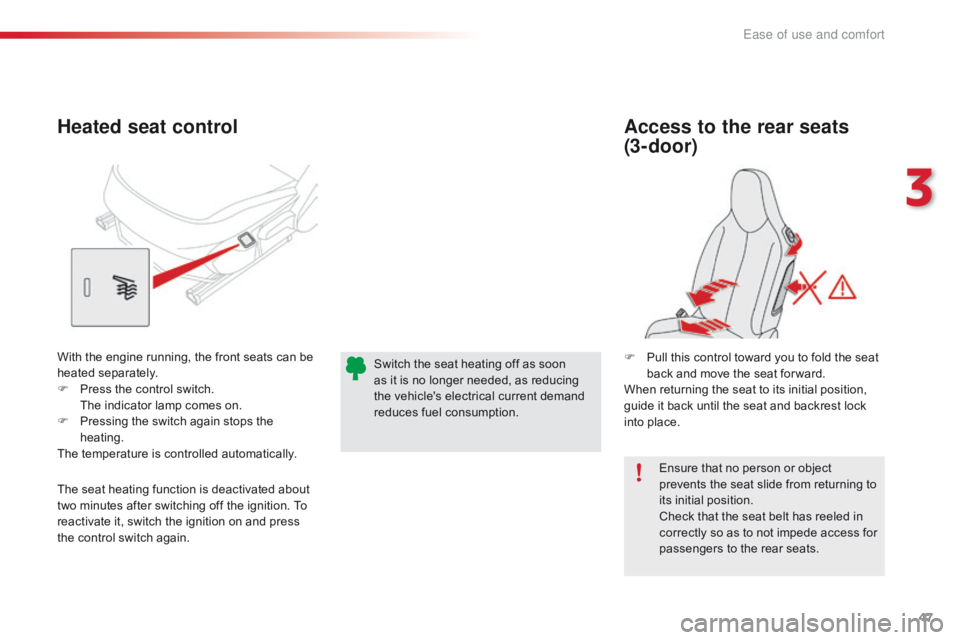
47
C1_en_Chap03_ergonomie-confort_ed01-2016
Ensure that no person or object prevents the seat slide from returning to
it
s
in
itial
p
osition.
Check
that the seat belt has reeled in
c
orrectly so as to not impede access for
p
assengers to the rear seats.
Heated seat control Access to the rear seats
(3-door)
F Pull this control toward you to fold the seat b
ack and move the seat for ward.
When
returning the seat to its initial position,
g
uide it back until the seat and backrest lock
i
nto place.
With
the
engine
running,
the
front
seats
can
be
h
eated s
eparately.
F
P
ress
the
control
switch.
T
he
indicator
lamp
comes
on.
F
P
ressing
the
switch
again
stops
the
hea
ting.
The
temperature
is
controlled
automatically.
The
seat
heating
function
is
deactivated
about
t
wo
minutes
after
switching
off
the
ignition.
To
r
eactivate
it,
switch
the
ignition
on
and
press
t
he
control
switch
again. Switch
the
seat
heating
off
as
soon
a
s
it
is
no
longer
needed,
as
reducing
t
he
vehicle's
electrical
current
demand
r
educes
fuel
consumption.
3
Ease of use and comfort
Page 73 of 269
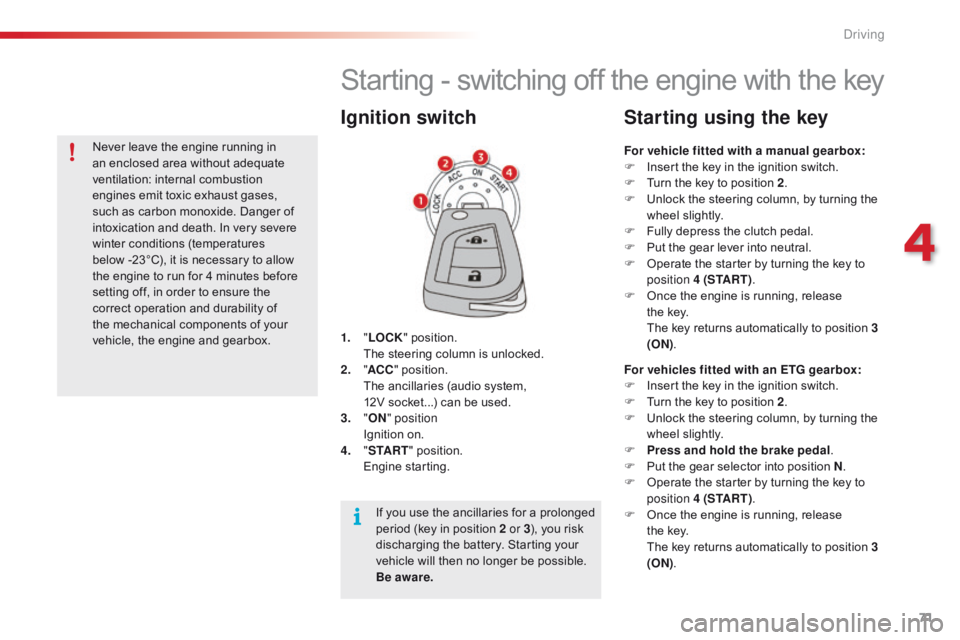
71
C1_en_Chap04_conduite_ed01-2016
Starting - switching off the engine with the key
1. "LOCK " position. T
he steering column is unlocked.
2.
" AC
C"
position.
T
he ancillaries (audio system,
1
2V socket...) can be used.
3.
"ON " position
I
gnition on.
4.
" S
TA R T"
position.
E
ngine
s
tarting.
Ignition switch
For vehicle fitted with a manual gearbox:
F I nsert the key in the ignition switch.
F
T
urn the key to position 2.
F
U
nlock the steering column, by turning the
w
heel slightly.
F
F
ully depress the clutch pedal.
F
P
ut the gear lever into neutral.
F
O
perate the starter by turning the key to
p
osition 4 (S TA R T ) .
F
O
nce the engine is running, release
t
he key.
T
he key returns automatically to position 3
(ON) .
Starting using the key
For vehicles fitted with an ETG gearbox:
F
I nsert the key in the ignition switch.
F
T
urn the key to position 2.
F
U
nlock the steering column, by turning the
w
heel slightly.
F
P
ress and hold the brake pedal .
F
P
ut the gear selector into position N.
F
O
perate the starter by turning the key to
p
osition 4 (S TA R T ) .
F
O
nce the engine is running, release
t
he key.
T
he key returns automatically to position 3
(ON) .
If
you
use
the
ancillaries
for
a
prolonged
p
eriod
(key
in
position
2 or 3 ),
you
risk
d
ischarging
the
battery.
Starting
your
v
ehicle
will
then
no
longer
be
possible.
B
e aware.
Never
leave
the
engine
running
in
a
n
enclosed
area
without
adequate
v
entilation:
in
ternal
c
ombustion
e
ngines
emit
toxic
exhaust
gases,
s
uch
as
carbon
monoxide.
Danger
of
i
ntoxication
and
death.
In
very
severe
w
inter
conditions
(temperatures
b
elow -23°C),
it
is
necessary
to
allow
t
he
engine
to
run
for
4
minutes
before
s
etting
off,
in
order
to
ensure
the
c
orrect
operation
and
durability
of
t
he
mechanical
components
of
your
v
ehicle,
the
engine
and
gearbox.
4
Driving
Page 74 of 269
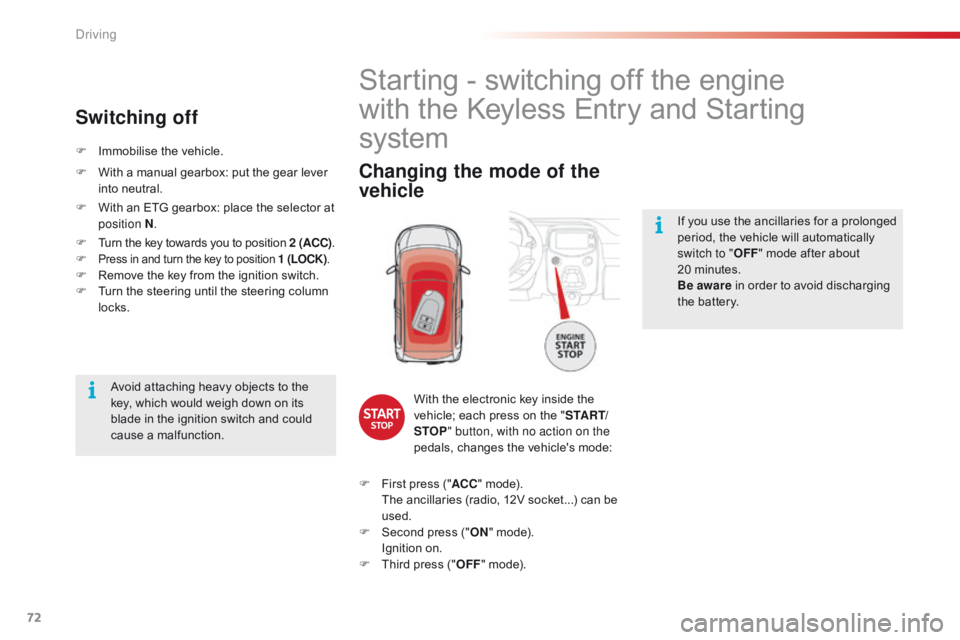
72
C1_en_Chap04_conduite_ed01-2016
If you use the ancillaries for a prolonged period, the vehicle will automatically
s
witch to " OFF"
mode after about
20
m
inutes.
Be aware
in order to avoid discharging
t
he battery.
Starting - switching off the engine
w ith the Keyless Entry and Starting
system
Changing the mode of the
vehicle
With the electronic key inside the v
ehicle; each press on the "S TA R T/
STOP " button, with no action on the
pedals,
changes the vehicle's mode:
F
F
irst
press ("ACC "
mode).
T
he
ancillaries (radio, 12V socket...) can be
u
sed.
F
S
econd press ("ON "
mode).
I
gnition on.
F
T
hird
press ("OFF "
mode).
Avoid
attaching
heavy
objects
to
the
k
ey,
which
would
weigh
down
on
its
b
lade
in
the
ignition
switch
and
could
c
ause
a
malfunction.
F
I
mmobilise
the
vehicle.
Switching off
F With
a manual gearbox: put the gear lever i
nto neutral.
F
W
ith an ETG gearbox: place the selector at
p
osition N .
F
T
urn the key towards you to position 2 (ACC).
F
Press in and turn the key to position 1 (LOCK) .F Remove the key from the ignition switch.
F T urn the steering until the steering column
l
ocks.
Driving
Page 75 of 269
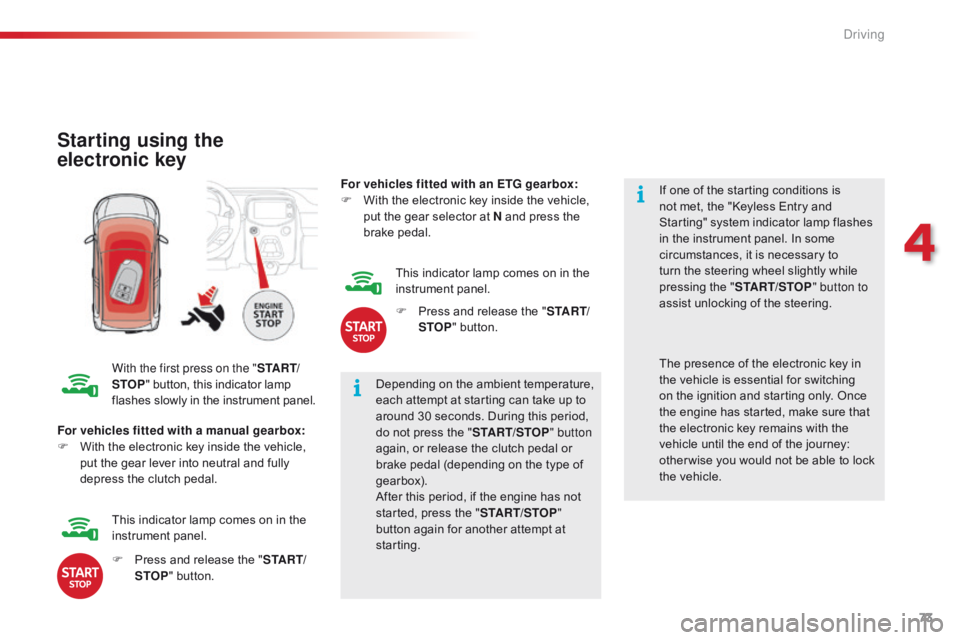
73
C1_en_Chap04_conduite_ed01-2016
Starting using the
electronic key
With the first press on the "S TA R T/
STOP "
button, this indicator lamp f
lashes slowly in the instrument panel.Depending
on the ambient temperature,
e
ach attempt at starting can take up to
a
round 30 seconds. During this period,
d
o not press the "START/STOP " button
again,
or release the clutch pedal or
b
rake pedal (depending on the type of
g
earbox).
After
this period, if the engine has not
s
tarted, press the "START/STOP "
button
again for another attempt at
s
tarting. If
one of the starting conditions is
n
ot met, the "Keyless Entry and
S
tarting" system indicator lamp flashes
i
n the instrument panel. In some
c
ircumstances, it is necessary to
t
urn the steering wheel slightly while
p
ressing the "
START/STOP " button to
assist unlocking of the steering.
For vehicles fitted with a manual gearbox:
F
W
ith
the electronic key inside the vehicle,
p
ut
the gear lever into neutral and fully
d
epress the clutch pedal. The
presence of the electronic key in t
he vehicle is essential for switching
o
n the ignition and starting only. Once
t
he engine has started, make sure that
t
he electronic key remains with the
v
ehicle until the end of the journey:
o
ther wise you would not be able to lock
t
he vehicle.
F
P
ress and release the "S TA R T/
STOP "
button.
This
indicator lamp comes on in the
in
strument
pan
el. For vehicles fitted with an ETG gearbox:
F
W
ith the electronic key inside the vehicle,
p
ut the gear selector at N and press the
b
rake
ped
al.
This indicator lamp comes on in the
in
strument
pan
el.
F
P
ress and release the "
S TA R T/
STOP " button.
4
Driving
Page 77 of 269
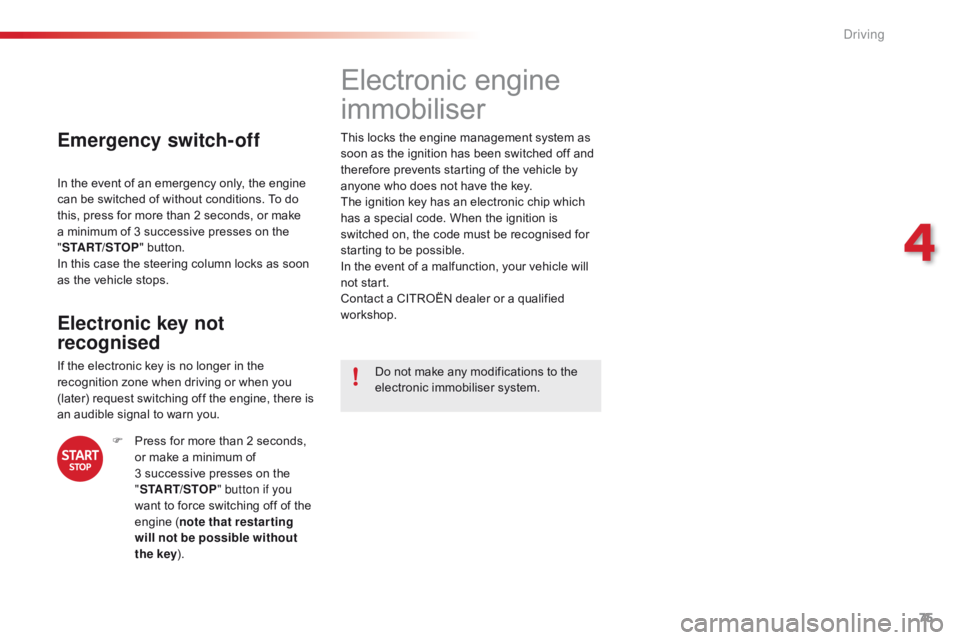
75
C1_en_Chap04_conduite_ed01-2016
Emergency switch-off
In the event of an emergency only, the engine can be switched of without conditions. To do
t
his, press for more than 2 seconds, or make
a
minimum of 3 successive presses on the
"ST
ART/STOP "
button.
In
this case the steering column locks as soon
a
s the vehicle stops.
Electronic key not
recognised
If the electronic key is no longer in the recognition zone when driving or when you
(
later) request switching off the engine, there is
a
n audible signal to warn you.
F
P
ress for more than 2 seconds,
o
r make a minimum of
3 s
uccessive presses on the
"ST
ART/STOP" button if you
want
to force switching off of the
e
ngine (note that restarting
will not be possible without
the
key).
Electronic e ngine
i
mmobiliser
This locks the engine management system as s
oon as the ignition has been switched off and
t
herefore prevents starting of the vehicle by
a
nyone who does not have the key.
The
ignition key has an electronic chip which
h
as a special code. When the ignition is
s
witched on, the code must be recognised for
s
tarting to be possible.
In
the event of a malfunction, your vehicle will
n
ot start.
Contact
a CITROËN dealer or a qualified
w
orkshop. Do
not make any modifications to the
e
lectronic immobiliser system.
4
Driving
Page 78 of 269
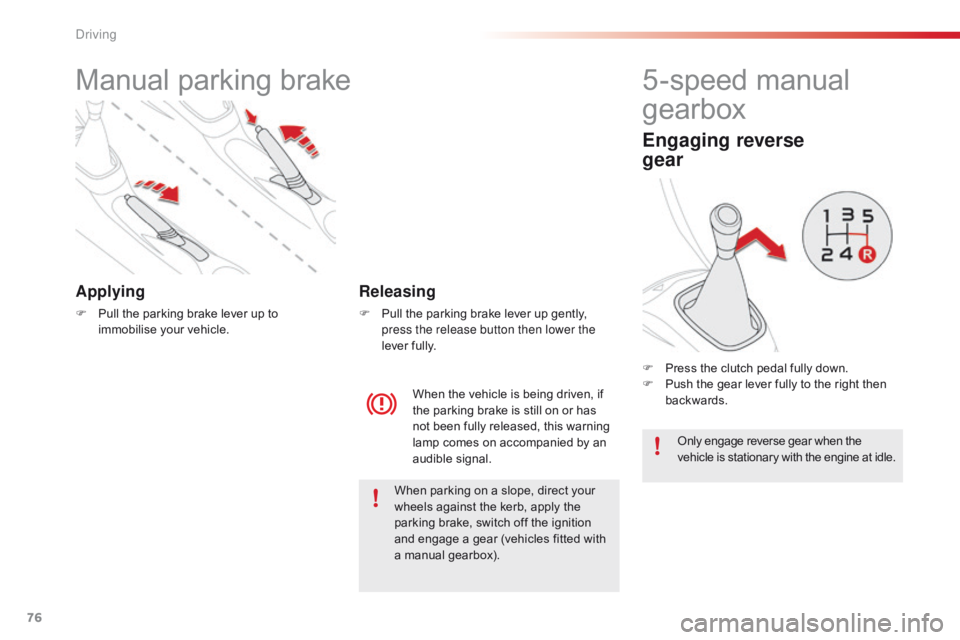
76
C1_en_Chap04_conduite_ed01-2016
Manual parking brake
Applying
F Pull the parking brake lever up to i
mmobilise your vehicle.
When
the vehicle is being driven, if
t
he parking brake is still on or has
n
ot been fully released, this warning
l
amp comes on accompanied by an
a
udible
s
ignal.
Releasing
F Pull the parking brake lever up gently, p
ress the release button then lower the
lever
f
ully.
5-speed manual
g
earbox
Engaging reverse
gear
F Press the clutch pedal fully down.
F P ush the gear lever fully to the right then
ba
ckwards.
Only
engage reverse gear when the
v
ehicle is stationary with the engine at idle.
When
parking
on
a
slope,
direct
your
w
heels
against
the
kerb,
apply
the
p
arking
brake,
switch
off
the
ignition
a
nd
engage
a
gear
(vehicles
fitted
with
a
manual
gearbox).
Driving
Page 82 of 269
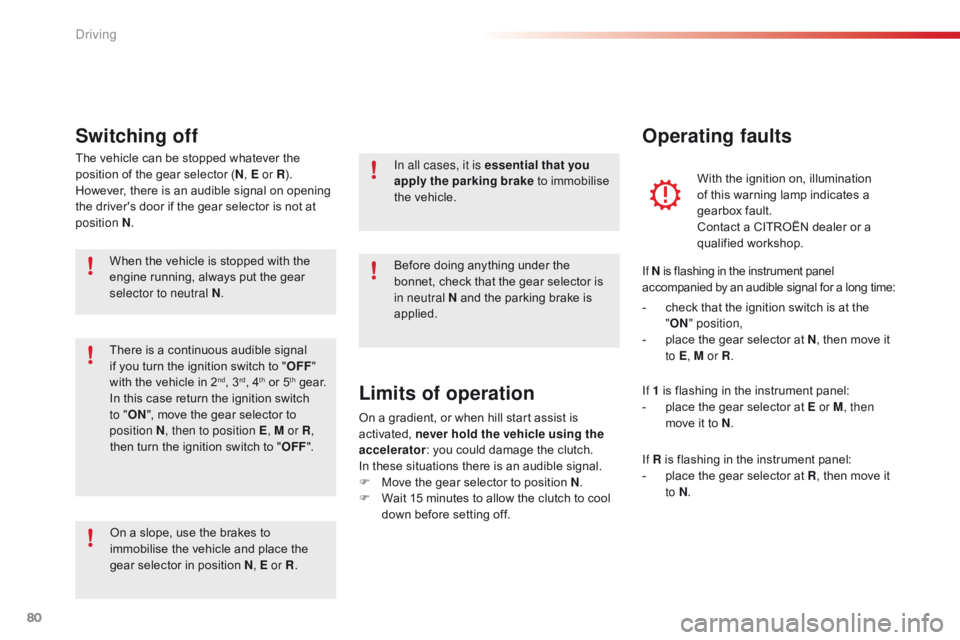
80
C1_en_Chap04_conduite_ed01-2016
The vehicle can be stopped whatever the position of the gear selector (N , E or R ).
However,
there is an audible signal on opening
t
he driver's door if the gear selector is not at
p
osition N .
Switching off
When the vehicle is stopped with the e
ngine running, always put the gear
s
elector to neutral N .
There
is a continuous audible signal
i
f you turn the ignition switch to "OFF "
with
the vehicle in 2
nd, 3rd, 4th or 5th ge a r.
In
this
case
return
the
ignition
switch
t
o " ON ",
move
the
gear
selector
to
p
osition
N , then to position E , M or R,
then
turn
the
ignition
switch
to
" OFF ".
On
a
slope,
use
the
brakes
to
i
mmobilise
the
vehicle
and
place
the
g
ear
selector
in
position
N , E or R . With
the ignition on, illumination
o
f this warning lamp indicates a
g
earbox fault.
Contact a CITROËN dealer or a
q
ualified
w
orkshop.
Operating faults
In all cases, it is essential
that you
apply the parking brake to immobilise
t
he vehicle.
Before
doing anything under the
b
onnet, check that the gear selector is
i
n neutral N and the parking brake is
a
pplied.
Limits of operation
On a gradient, or when hill start assist is activated, n ever hold the vehicle using the
accelerator :
you could damage the clutch.
In
these situations there is an audible signal.
F
M
ove the gear selector to position N.
F
W
ait 15 minutes to allow the clutch to cool
d
own before setting off. -
c
heck that the ignition switch is at the
"
O
N
"
position,
-
p
lace the gear selector at N
, then move it
t
o E
, M or R .
If 1 is flashing in the instrument panel:
- p lace the gear selector at E or M
, then
move it to N.
If R
is flashing in the instrument panel:
-
p
lace the gear selector at R,
then move it
t
o N.
If
N is flashing in the instrument panel
a
ccompanied by an audible signal for a long time:
Driving
Page 88 of 269
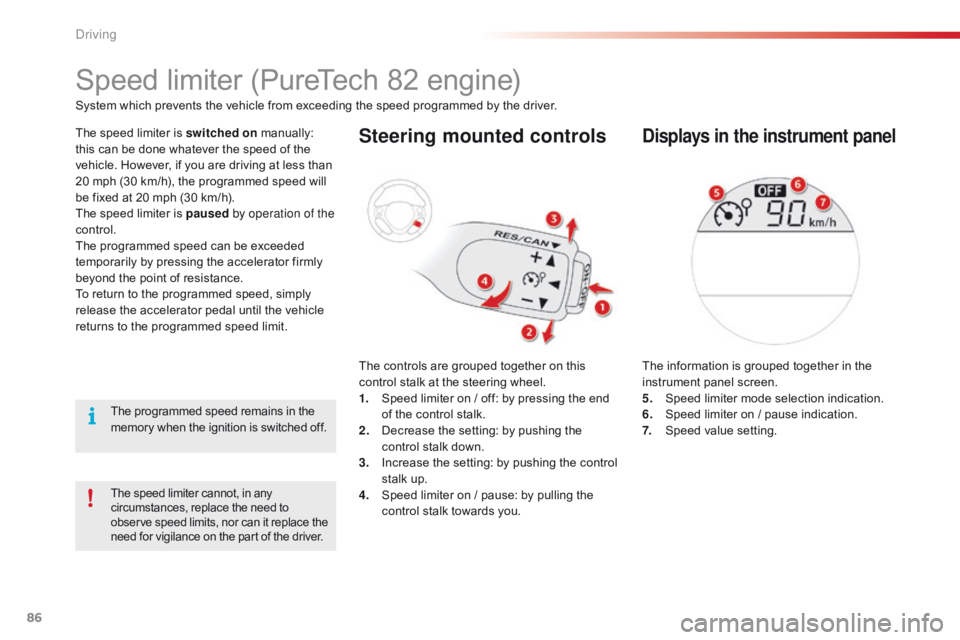
86
C1_en_Chap04_conduite_ed01-2016
The speed limiter cannot, in any circumstances, replace the need to o
bserve speed limits, nor can it replace the
n
eed for vigilance on the part of the driver.
Speed limiter (PureTech 82 engine)
The speed limiter is switched on manually: t
his can be done whatever the speed of the
v
ehicle. However, if you are driving at less than
2
0 mph (30 km/h), the programmed speed will
b
e fixed at 20 mph (30 km/h).
The
speed limiter is paused by operation of the
control.
The
programmed speed can be exceeded
t
emporarily by pressing the accelerator firmly
b
eyond the point of resistance.
To
return to the programmed speed, simply
r
elease the accelerator pedal until the vehicle
r
eturns to the programmed speed limit.
System
which prevents the vehicle from exceeding the speed programmed by the driver.Steering mounted controls
The controls are grouped together on this c
ontrol stalk at the steering wheel.
1.
S
peed limiter on / off: by pressing the end
o
f the control stalk.
2.
D
ecrease the setting: by pushing the
c
ontrol stalk down.
3.
I
ncrease the setting: by pushing the control
s
talk up.
4.
S
peed limiter on / pause: by pulling the
c
ontrol stalk towards you.
Displays in the instrument panel
The information is grouped together in the instrument panel screen.
5.
S
peed limiter mode selection indication.
6.
S
peed limiter on / pause indication.
7.
S
peed value setting.
The
programmed
speed
remains
in
the
m
emory
when
the
ignition
is
switched
off.
Driving